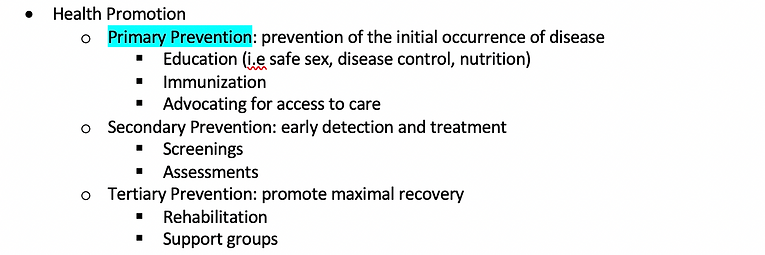
Preventing Illness through Education
Key Insight 2
In Population Health Nursing (NURS 431), we focus on the concept of health promotion. Within this concept, there are three levels of disease prevention. (Artifact 1: Public health notes) The focus of this key insight will be on the primary level of prevention, which is essentially preventing disease and injury through education. Throughout my clinical experience beyond the classroom, I have had many patients whose admission could have been prevented by simple lifestyle changes. Whether that is due to a lack of education or a lack of compliance is often undetermined. However, I have learned that I can never overeducate my patients and that I should use every opportunity to improve a patient’s understanding of their diagnosis.
Primary level of prevention is aimed at preventing disease or injury from ever occurring. This is achieved by educating patients on their predisposed illnesses. In Nursing Leadership and Management (NURS 428), I learned about health disparities that people are predisposed to by living in a rural area like Lancaster, SC (Artifact 2: Rural areas DB). In this artifact, I discuss how one of the health disparities in Lancaster county is the lack of education on one’s health. As a health care provider in Lancaster, I can use this knowledge to implement primary prevention through education to improve the health of my community.
As Director of Membership of the Student Nursing Association (SNA) at Lancaster, my goal was to provide SNA members with opportunities to implement Primary Prevention in our community. In my first SNA meeting as Director of Membership, I explained how involvement within the community is a primary prevention strategy (Artifact 3: SNA meeting 1 notes). To implement this strategy, the plan was for SNA to attend various community events where we would provide health education. Due to COVID, these opportunities to educate those in our community were extremely limited. Fortunately, SNA was able to partner with our local Department of Health and Environmental Control (DHEC) to assist in the development of an on-coming campus clinic, the Hubb. The Hubb’s goal is aimed at providing students with basic health examinations and contraceptive methods. This new clinic, that SNA is a part of developing, will provide the opportunity for nursing students to educate our fellow peers on the importance of safe sex. My role as the Director of Membership was vital in the development process of the clinic. I presented opportunities to the SNA members to assist with various events regarding the Hubb, such as assisting with the maintenance of the Hubb location.
Through my role as a Peer Advisor at Lancaster (PALs), I participated in a mask awareness campaign for our incoming freshman. For this campaign, pictures of PALs wearing their favorite mask were posted around campus (Artifact 4: mask picture). This campaign was an opportunity to educate my fellow peers on the importance of wearing a mask and social distancing to prevent the spread of COVID 19. Educating my fellow peers and personally implementing mask wearing was another example of primary prevention. By wearing a mask while in social settings it prevented the contraction and spread of COVID 19.
During my Sophomore year I was involved was the Student Mobile Anthropometric Research Team (SMART) Study. For this study, we collected various data on health indicators among two-year college students. Data that were collected included handgrip strength, waist and hip circumference, and a survey that asked about activity levels. Based on the data collected each team member conducted their own research study. My personal abstract was “Differences in Waist Circumference, Body Fat Percentage, and Hand Grip Strength Between Frame Sizes in Women.” (Artifact: Discover USC poster) This research focused on the health risk that participants were predisposed to based on handgrip strength and waist and hip circumference. The results showed that women with larger frame sizes could be at risk for developing sarcopenic obesity. Presenting my findings at Discover USC in 2019, gave me the opportunity to educate others on the health risks that were discussed in my research. This provides another example of how primary prevention through education can be implemented.
Taking the time to educate our community may seem like a tedious and insignificant task in which the benefits are not Immediately evident. However, this task can decrease the prevalence of disease and injury in our community. That is why in my future clinical practice, I will aim to intentionally implement this primary prevention strategy. I plan to continue to stay actively involved within my community to achieve this plan.


Artifact 4
BTC
pictures were displayed on monitors across campus of PALs wearing their favorite mask
Artifact 5
BTC
Discover USC Poster
